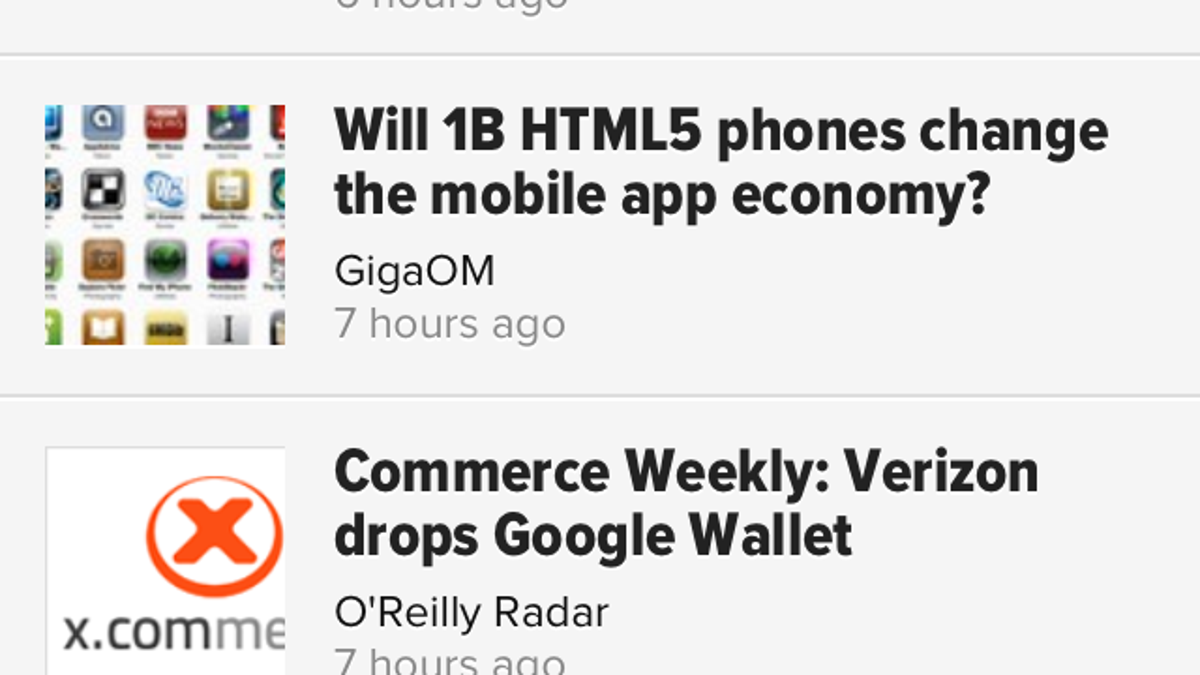Zite for iPhone: An elegant, personalized reader
Its iPad version is a popular alternative to Flipboard due to Pandora-like personalization. It scaled its elegant offering down for iPhone, but at a price to personalization options. Its timing also coincided with Flipboard and Google Current's iPhone app unveilings.

It's been a great week to be a news junkie with an iPhone. On Tuesday, iPad darling Flipboard finally appeared on Apple's smart phone. Yesterday, Google launched its aggregator, Currents. And today, completing the trifecta, Zite unveiled its all-new iPhone app.
Previously, Zite had been available solely for the iPad. It established its place in the increasingly crowded aggregator field by focusing on personalization--giving users something of a Pandora-like experience with news: Like something and want to see more from a specific publication or writer? No problem.
Now, the company--which was bought by CNN in August for a rumored $20 million-plus--has come to the iPhone, bringing with it a scaled-down version of the personalization iPad users have become accustomed to, and adding an attractive, simple, one-handed user experience that could lure a slew of new fans.
Indeed, said Zite CEO Mark Johnson, bringing the aggregator to the iPhone has been existing users' number one request.
Riding the bus
The trick for any aggregator wanting to make the jump to the iPhone from tablets like the iPad is figuring out a smart system for transitioning from presenting news in a way that will satisfy users when they're lounging on their couch to one that will scratch users' itch for short bursts of news when they're standing in line for coffee.
With its iPhone app, Zite has successfully made that transition. It is fast and smooth--because it was built to pre-cache most information--and the company has come up with some simple, elegant ways to handle things like choosing news categories and selecting and scrolling through individual stories.
Those who are already Zite users can sign in with their existing logins, and get right to browsing the categories they've already set up. New users can go through a quick sign-up process during which they identify news topics they're interested in.
Once inside the app, users flick through a "carousel" of topics--arrayed in a small bar across the top of the screen--with their thumb. The categories are listed alphabetically to the right of a Top Stories section. Unfortunately, there's no way to re-order the topics in a way that puts someone's favorites first.
Within a category, all the relevant stories appear below the bar, with the most recent first, four at a time. Users scroll down the screen to see older articles. On a good Wi-Fi connection, the scrolling action, both to move between topics, and between stories, is smooth and intuitive to any veteran iPhone user. But those on slow Wi-Fi or 3G signals may find themselves waiting a short while for things to load.
One of the biggest selling points of the iPad version of Zite is that users can seed the news they'll get in the future by saying if they liked an individual story or not, as well as asking to see more from a particular news site or author, or topic within a story. As with Pandora, the more information they provide, the better the system is at predicting what they'll want in the future.
With the iPhone app, however, it's possible only to give a thumbs-up or down for a story, although Zite says it also learns what you are interested in based on the stories you choose. But that would seem to indicate that personalization will come slower on the iPhone, at least for users that don't also have an iPad. That's "a design decision that we consciously made to minimize the number of levers that a user has for personalization," Johnson said, though he also said that Zite sees the two versions of its aggregator as being complementary to each other..
'Acquisition off on a really good foot'
Although Johnson has shipped products before--both for Microsoft and Powerset--this is the first he's done as a CEO. At the same time, this is Zite's first big move since being bought by CNN, and to Johnson, being able to get the iPhone app out within a few months after the acquisition shows that it's "off on a really good foot."
Johnson said that after the CNN deal closed, everyone involved agreed on the strategy of finishing an iPhone app as soon as possible, even as Zite began the process of growing its staff. As for whether Zite will try to come out with an app next for Android tablets, Johnson said that in fact, there's an internal debate about whether to do that or whether to shoot for Android phones. There's "much more penetration with Android phones than Android tablets," he said.
And even as Zite's iPad app has gotten a lot of positive attention--though the company won't give any numbers about how many people have downloaded it, there's an internal expectation that the iPhone version will quickly surpass it in popularity. In fact, Johnson said, Zite employees have a pool going about how long that will take. He said his prediction is between 60 and 90 days.
Either way--and despite the fact that it's likely that iPhone users will spend less time per Zite session than do those with iPads--Johnson said that the number he really cares about is retention: Will iPhone users come back as often as their iPad brethren?
It's hard to say for sure, of course, but given the app's ease of use, and its ability to learn as you go, it's a good bet.

